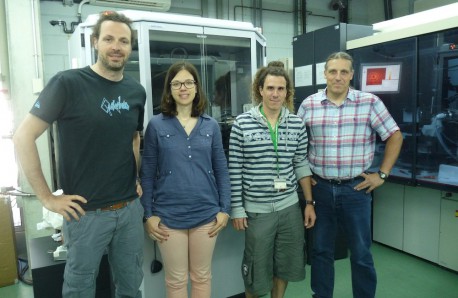X-Ray Diffraction Unit

THE UNIT IN 2014
The X-ray Diffraction Unit gathers all the techniques which are based on the diffraction of X-rays on crystalline solids. In this Unit two principal techniques are available: Powder X-ray Diffraction and Single Crystal X-ray Diffraction.
In the year 2014 the most relevant single crystal X-ray diffraction system of the Unit reached an age of 10 years and was retired from use. As replacement a new device from Rigaku (Japan) was purchased which started working on November 2014. This device delivered excellent results in the first measurements performed.
Our 2014 highlights:
- A new technique was reintroduced in the Unit: Crystallization “in situ” on the diffractometer by applying a melting zone with a CO2 laser.
- A new methodology developed in the X-Ray Diffraction Unit to determine absolute configuration of molecules containing only CHNO atoms with Molybdenum radiation was published in Acta Cryst. B: “The use of Mo Ka radiation in the assignment of the absolute configuration of light-atom molecules; the importance of high-resolution data”; Eduardo C. Escudero-Adán, Jordi Benet-Buchholz and Pablo Ballester; Acta Cryst. (2014). B70, 660-668.
- New techniques developed in 2013 were applied assiduously in 2014
- Variable temperature XR Powder Diffraction experiments within the range from -173ºC and 250ºC.
- The capability of measuring extremely air sensitive crystals using a methodology that implies the selection of the crystal in a glove box and freezing the crystal directly into the measuring loop.
- The Unit was also a user of the ALBA synchrotron facility. Powder diffraction beamline (BL04-MSPD) was used to quantify and determine limits of detection in pharmaceutical products.
- The X-Ray Diffraction Unit Staff participated in the “Pharmaceutical Solid State Development Workshop 2014” organized by ICIQ’s Crysforma.
- The Unit hosted a guest professor from the United States for a practical stay.
MOST IMPORTANT EQUIPMENT
- Two Single Crystal X-ray diffractometers: A Rigaku diffractometer equipped with a Pilatus 200K area detector, a Rigaku MicroMax-007HF microfocus rotating anode with MoKa radiation and Confocal Max Flux optics and Apex DUO diffractometer equipped with a Kappa 4-axis goniometer, an APEX II 4K CCD area detector, a Microfocus Source E025 IuS using MoKa radiation and Quazar MX multilayer Optics as monochromator. Both devices are supplied with an Oxford Cryosystems low temperature device Cryostream 700 plus (T = -173 °C)
- Powder X-ray diffractometer from Bruker® (D8 Advance) in transmission geometry equipped with a Germanium monochromator, a linear Våntec detector (12º) and a ninety-position auto changer sample stage.
- Microscope: Zeiss® Stemi SV11 Stereomicroscope.